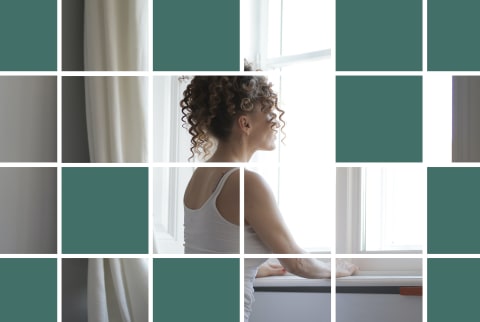Ideally, the schedule of your internal clock will sync up with your external clock and you’ll be exposed to stimulating sun during the day and calming darkness at night. Of course, this isn’t always possible—especially if you’re working night shifts, studying long hours at school1, or traveling across time zones. “Circadian misalignment also occurs when an individual’s chronotype is at odds with their environment, e.g., when someone who is an ‘owl’ and prefers to be active in the evening is forced to be at work early in the morning,” adds Sofia Axelrod, Ph.D., a circadian clock researcher. Misalignment between your light exposure and your body clock can have a negative impact on your sleep2, blood sugar management3, cardiovascular system4, and even skin health5. Well-timed light, on the other hand, has been shown to improve mood6 and overall life satisfaction7 (though it’s not always clear whether these benefits are the result of the circadian system or a direct effect of the light itself). In the last few years, Axelrod has seen this circadian research begin to impact our medical system. For starters, it’s caused more sleep doctors to recommend keeping a dark bedroom in order to improve sleep quality—and reduce your risk of obesity, diabetes, and high blood pressure8 too. (One study published in PNAS found that just one night of moderate light exposure was enough to increase heart rate and next-morning insulin resistance9 compared to a night of dim light exposure in healthy adults.) It’s also caused people to be more selective about their cellphone use, at least in the hours before bed, since the artificial blue light from our phones is stimulating and can be detrimental to sleep10. More recently, the conversation around daytime light exposure has also picked up on social media. (Just look to the #circadian hashtag on TikTok—a compilation of videos of people getting out in the sunshine for the sake of their sleep and mood that has amassed 680.8K views.) “Morning light is probably the most important for most people in order to keep their clocks on track,” says Hasler, since the average time it takes our internal clocks to go through a full cycle is 24.2 hours (cycles can range from less than 24 hours to over 25 hours). This means that we need to essentially turn our clocks back by 12 minutes each day, which morning sun exposure can help with. Evening light works against this. As licensed clinical psychologist Aric Prather, Ph.D., explained on his episode of the mindbodygreen podcast, it can also be beneficial to “bundle” your morning sun with other healthy practices like walking and having social interactions. However, Hasler caveats, “While morning light seems particularly important, it’s not like the light the rest of the day is not important” since natural sun exposure throughout the day seems to have a positive impact on our sleep and mental alertness. Clearly, optimum light is something we should always be striving for, but the demands of modern life don’t make it easy. That’s where making small adjustments in the place you do have control over—your home—can have a bright impact. “I see a huge untapped potential in the application of circadian rhythms research in our lives,” says Axelrod. Looking forward to the future, we predict that people will pay more attention to not just optimizing their homes for different activities but different facets of health—starting with circadian health. Then, there is the rise in products that seek to block light out during the hours that you don’t want it. “Everybody sleeps better in the dark,” says Hannah Brennen, the co-founder of portable blackout curtain company Sleepout. When she launched the company on Kickstarter with her husband, Mark Coombs, last June, she didn’t expect it to speak to so many people: The couple raised $295,000 in 35 days and has since gone on to secure over 18,000 customers—a combination of people who work at night, have restless young kids, or just understand the positive role that darkness has on sleep quality. Dave Asprey, the founder of TrueDark blue-light-blocking glasses and TrueLight, a lighting line that mimics the colors found in nature, has seen circadian-rhythm-supporting products go mainstream as more people become aware that “our bodies respond to light and our sleep quality (and overall performance) depends on the type of light we are exposed to and when.” Brennan and Coombs from Sleepout predict that as public awareness on this topic continues to grow, the most popular products for sleep won’t be the most luxurious pillows or the highest thread-count sheets. They’ll be the tools that get down to our biological sleep needs. Read our full trend list for 2023 here. Emma received her B.A. in Environmental Science & Policy with a specialty in environmental communications from Duke University. In addition to penning over 1,000 mbg articles on topics from the water crisis in California to the rise of urban beekeeping, her work has appeared on Grist, Bloomberg News, Bustle, and Forbes. She’s spoken about the intersection of self-care and sustainability on podcasts and live events alongside environmental thought leaders like Marci Zaroff, Gay Browne, and Summer Rayne Oakes.




